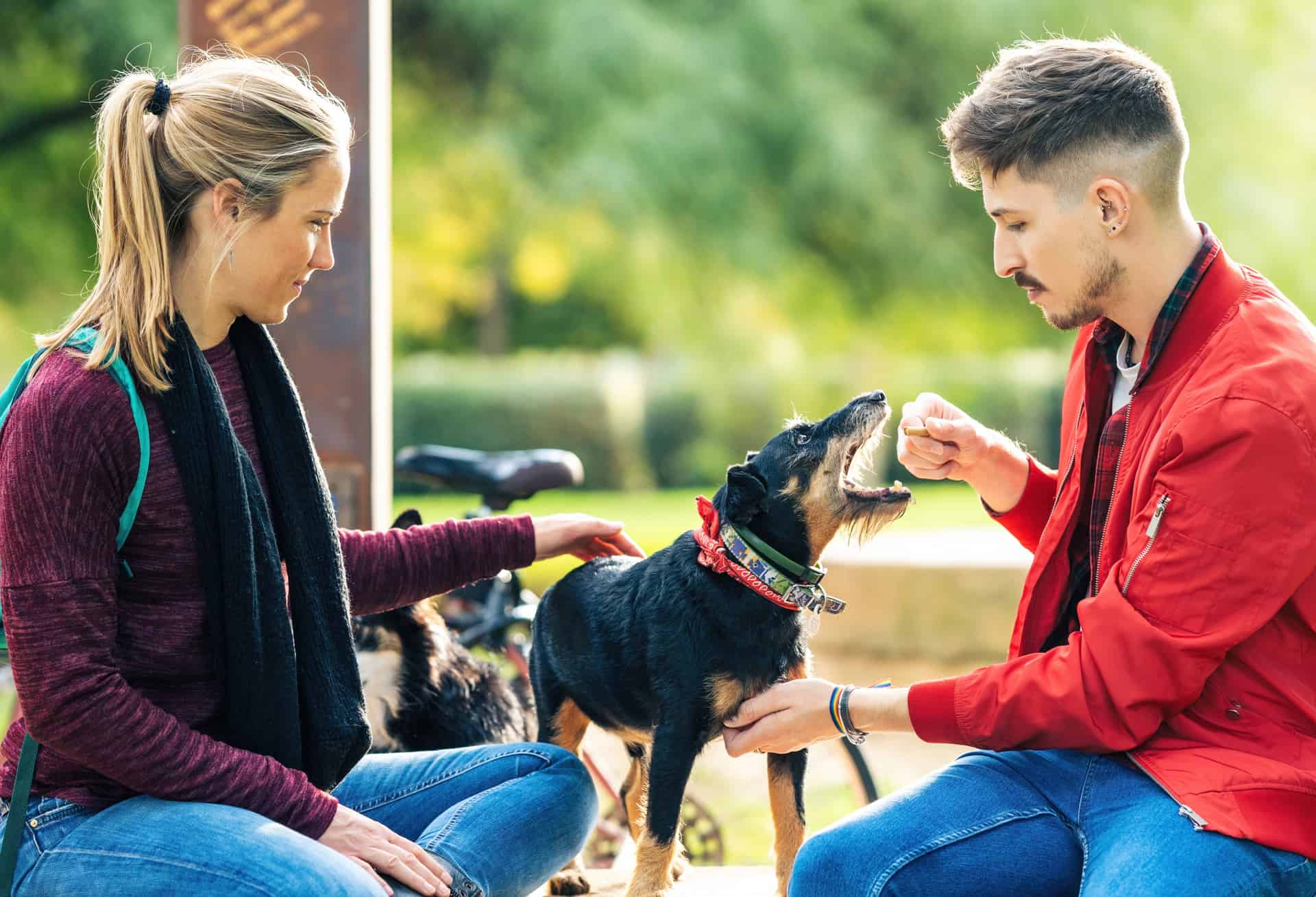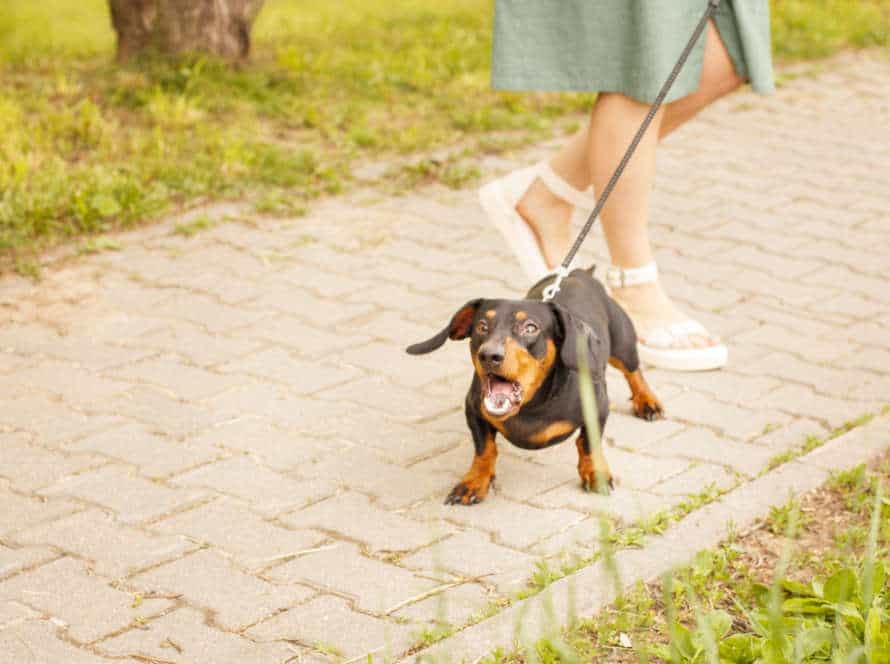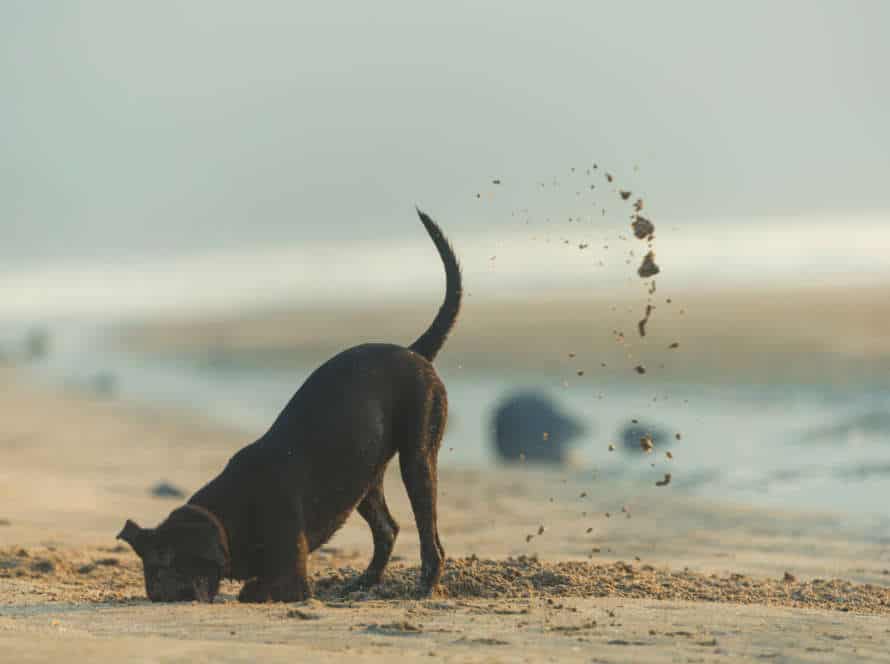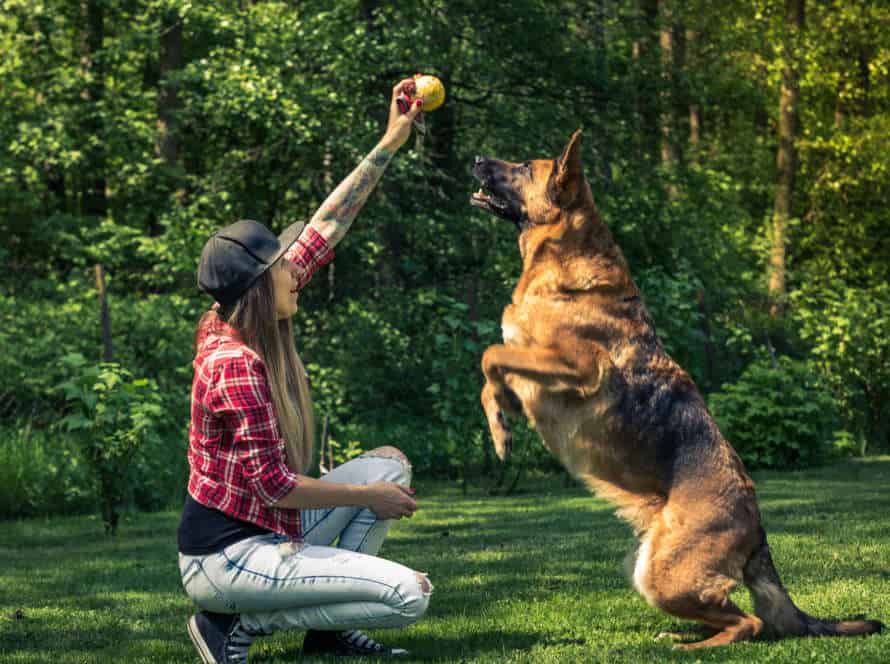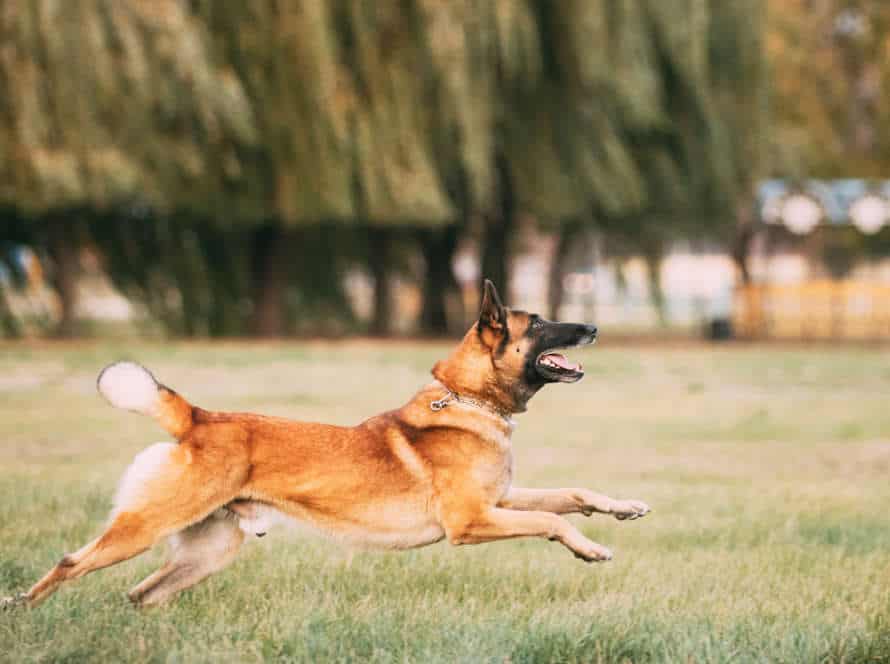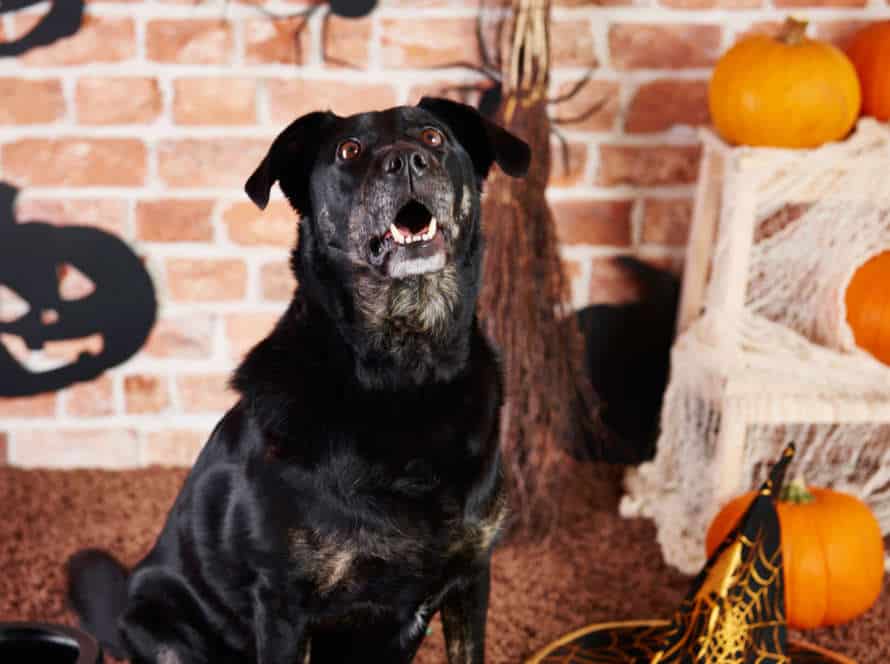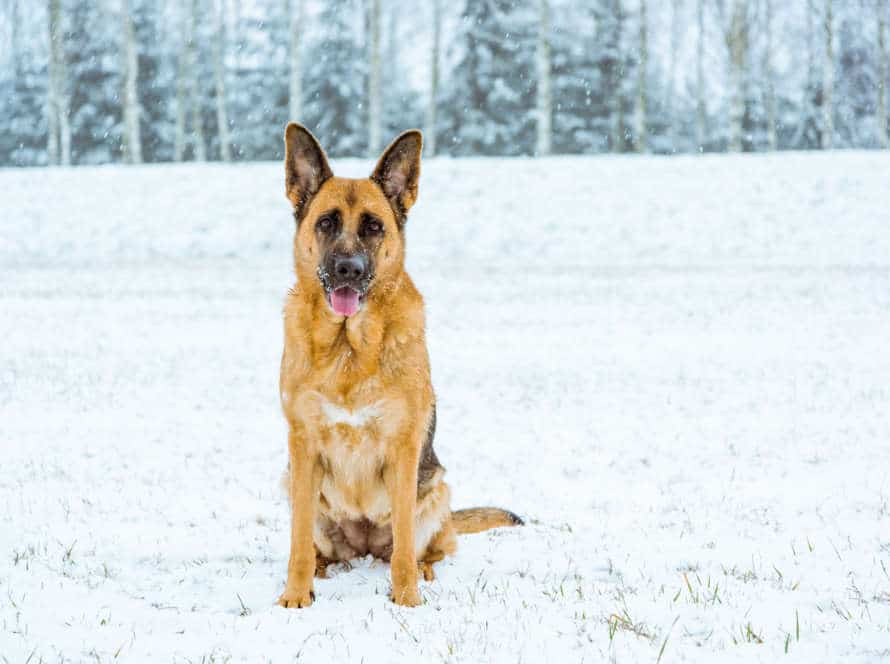The Power of Distraction: Redirecting Your Dog’s Energy
The Power of Distraction is a great tool for teaching your pup. Here’s how to use it:
- Identify triggers like squirrels, cars, or other dogs.
- Use things your pup likes, like treats or praise, to reward good behavior.
- Introduce distractions slowly and from a safe distance.
- Redirect your pup’s attention to something positive, like playing.
- Practice distraction often and be consistent.
- Always watch for reactions and adjust training.
Pro Tip: Patience is key!
Understanding Dog Distractions
Gaining insight into what distracts dogs can be vital when they become too absorbed in something. This is especially useful when teaching your pup, as being able to pick up on when their attention isn’t on the behavior you are aiming for can make all the difference. So, let’s explore the different types of distractions and the best ways to re-direct your pup’s energy when necessary.
The Importance of Recognizing Distractions in Dogs
Recognizing distractions in dogs is essential for their training and behavior. Distractions can be sights, sounds, or smells. Knowing these can help with redirecting energy and improving focus. Common distractions include other dogs/animals, loud noises, unfamiliar people, and enticing smells.
Redirecting their energy involves providing positive distractions such as treats, toys, or verbal commands. Dogs can learn to overcome distractions and obey commands with proper training and attention.
Keep track of what diverts a dog’s attention and find ways to reduce it. With proper training, many distractions can be managed. This leads to a well-behaved and obedient companion.
Pro tip: Start with an easy routine with few distractions. Progressively increase difficulty as your dog gets better at focusing.
Common Types of Distractions for Dogs
Dogs, like humans, can be easily distracted. Pet owners should be aware of common distractions.
Smells may lead them off course. Loud or high-pitched sounds can make them anxious. Moving or unusual objects, animals or people can be distracting. Touch can trigger excitement or anxiety.
Once you know what distracts your dog, use distraction to redirect their energy. Train and redirect your dog’s focus. This can help keep them calm and well-behaved.
How Distractions Affect Training and Behavior
Distractions can have a huge effect on how dogs behave and how we train them. Dogs, like people, have short attention spans. When they get distracted, it can be hard to re-focus them. Knowing how distractions affect dog training can help you create techniques that work for you and your pup.
Common distractions for dogs are:
- External stuff like other animals, people and vehicles.
- Internal things like hunger and anxiety.
- Inconsistent training techniques.
- Lack of play or interaction with their owner.
Redirecting your dog’s energy is a way to help them ignore distractions. Positive reinforcement like treats or toys helps regain their focus. Also, reducing external distractions and having a dependable training routine will help improve their behavior. Pro tip: Have patience and be consistent when training your pup, and you’ll get results in the long run.
Positive Reinforcement Training Techniques
Positive reinforcement training is a great way to turn your pup’s energy around! It involves rewards and praising the dog when they do something right. This type of training helps your pooch learn by linking desired behaviors with rewards. By using these techniques, you can quickly teach your dog how to listen to commands.
Using Treats as a Positive Reinforcement Tool
Treats are a great way to reward your pup’s good behavior. But be sure to use them sparingly, so you don’t overfeed and create bad habits. Here are some tips:
- Choose treats your dog loves that are also healthy and high quality.
- Reinforce positive behavior with treats – like following commands, coming when called or being calm around other dogs.
- Don’t use treats as a bribe or to distract from bad behavior.
- Gradually reduce the amount of treats you give your dog as they learn commands.
- Don’t forget to add plenty of praise, petting and playtime.
- Pro tip – try different types of treats, like small pieces of chicken or cheese cubes, to discover your pup’s favourite.
Shaping Behavior Through Positive Reinforcement
Positive Reinforcement: A training technique to promote good behaviour in dogs.
The Power of Distraction: Redirect energy and reinforce positive behaviour.
Here’s how:
- Get your pup a treat they love.
- When bad behaviour starts, give them the treat to focus on.
- Ask them to do a command they know, like ‘sit’ or ‘down’.
- Reward them with the treat and praise them when they obey.
- Gradually reduce the treats over time.
- Stay consistent with positive reinforcement.
Pro tip: For a long and happy relationship, use positive reinforcement!
Effective Timing and Rewards When Redirecting Attention
Timing and rewards are two of the most important parts of positive reinforcement training for dogs. It’s vital to understand when to reward good behavior. Here are some tips to help:
- Catch your pup’s attention before they get too excited.
- Give them a treat, toy, or praise to redirect their focus away from the trigger.
- Reward them when they reduce or stop the unwanted behavior.
Pro Tip: Consistency is key. Reward them when they do something right. Avoid harsh punishments.
Using Toys and Play to Redirect Energy
Toys – wow! What a great way to keep your pup’s energy focused. Plus, they can provide mental stimulation and help them stay active and healthy. But not all toys are equal, so let’s explore the different types. Then, let’s figure out how to use them correctly to re-direct your fur-friend’s energy.
Choosing the Right Toys for Distraction Training
Picking toys for distraction training can have a massive impact on redirecting your pup’s energy and improving behavior. Here’s a few tips to keep in mind:
- Choose toys that are tough and durable enough to endure vigorous play and chewing.
- Get a variety of toys like chew toys, tug toys, balls, and puzzles to keep your canine interested.
- Think about the size of the toy based on your dog’s breed and chewing behavior.
- Switch toys up regularly to hold your pup engaged and stop boredom.
- Play with your dog using the toys to help them link playtime with good behavior.
- Remember that the toys you choose can make a huge difference. The right toy can transform destructive or negative behavior into positive and playful behavior.
Benefits of Play for Redirecting Energy
Playing with your pup using toys or other fun activities is a great way to manage their energy and stop bad behavior like chewing and barking. Benefits of playtime for energy management include:
- Mental stimulus – Toys and games give your pup mental stimulation, keeping them active, preventing boredom and worry.
- Physical exercise – Playtime is also a way to give your pup physical exercise, helping their health.
- Bonding – Playtime is a chance to spend quality time with your pup, creating trust and togetherness.
- Stops destructive behavior – By managing energy with playtime, your pup won’t become bored & do destructive things.
Pro tip: Switch up your pup’s toys and games often to keep them interested.
Incorporating Playtime into Everyday Training
Incorporating playtime into daily training can be a great way to redirect your pup’s energy and make it more enjoyable. Here are some tips to get going:
- Utilize toys and play to refocus energy – Choose a toy your dog loves and use it during the training. Incorporate activities like tug-of-war or fetch to make it more interactive and entertaining.
- The power of diversion – If your pooch gets too excited or anxious, distract them with toys and play. This will help them calm down and focus on the task.
- Be consistent – Make sure you incorporate playtime into your everyday training. This will help your dog link training with enjoyable experiences.
- Keep it brief – Playtime should be a short break, not the entire session. Keeping play short will help keep the focus on training goals.
By including playtime in training, you can reduce stress, raise focus, and make it more pleasurable for you and your furry friend.
Creating Distraction-Free Environments
Redirecting your pup’s energy can be a great way to modify and manage unwanted behaviors. One of the best ways to do this is creating distraction-free environments. This means taking away anything that could stir up your pup’s bad behaviors. In this article, we’ll talk about what distraction-free environments are and how to make one effectively.
Reducing Environmental Distractions During Training Sessions
Reduce environmental distractions when training your pup! These tips can help:
- Choose a quiet, low-traffic spot.
- Reduce external noise and visual disturbances, e.g. switch off the TV or close blinds.
- Treats or toys can keep the pup’s attention.
- Gradually increase distractions as your dog learns.
- Keep session short & fun – redirect energy to training.
This way your pup can focus better & learn more effectively.
Creating a Safe, Comfortable Space for Training
To help your pup reach success in training, make sure you create a secure and relaxing space. A distraction-free room is the key to keeping your pup’s energy low and their focus high each session. So here are some tips for creating the perfect training environment:
- Locate a peaceful area without toys, people or other animals.
- If training outside, use a leash so they don’t get sidetracked by smells and noises.
- Set up a routine for the sessions to give your dog predictability and consistency.
- Use rewards for positive behaviors and create a cheerful connection with training.
- Whenever you notice their attention slipping, redirect their energy back to the task.
Keep in mind that consistency is vital when training your pup! So be patient and make it fun for you and your pup.
Importance of Distraction-Free Environments for Behavior Modification
Distraction-free environments are key for successful dog behavior change. They help dogs concentrate on the behavior you want, making training easier.
Here’s how to create a distraction-free environment for your pup:
- Choose a calm, familiar place to train, such as a quiet room in your house or a secluded spot in a park.
- Take away any potential distractions, such as toys, other pets, or loud appliances.
- Reward your pup’s good behavior with positive reinforcement instead of punishing bad behavior.
- Keep sessions short and fun to stop them from being too much for your pup and to keep them interested.
By having a distraction-free environment, you can help your pup reach their training goals faster and better.
Tip: Consistency is essential for effective behavior modification. Make distraction-free environments a regular part of your training routine.
Advanced Techniques for Redirecting Energy
Training your pooch is key! Redirecting energy can help break bad habits like barking or destructive behaviour. It can also help your pup stay focused. Advanced techniques can help your pup redirect energy away from distractions and towards tasks that help them grow. Let’s explore these advanced techniques and see how they can help redirect your pup’s energy!
Making Use of Clicker Training
Clicker training is a mighty, positive way to control your pup’s actions and behavior. It can be used in various methods.
These are a few of them:
- Capturing: Mark and reward the things your pet already does, like sitting or lying down.
- Shaping: Break down hard behaviors into smaller parts, then reward the pup as they move to the end result.
- Redirecting: Use the clicker to distract the pup from bad behavior and get them onto something better.
With clicker training, be patient, steady, and reward good behavior. With effort and positive reinforcement, your pup can learn new things and break bad habits.
Training Your Dog to Respond to Verbal Cues
Train your pup to listen to verbal commands. Here are tips to train them successfully:
- Start simple with “sit,” “stay,” and “come” then use treats or compliments for positive reinforcement.
- Move on to more complex commands when basics are mastered.
- Use one-word commands that are easy to remember and one at a time.
- Train in a quiet place, then add distractions as it gets harder.
- Include physical cues like hand gestures or body language.
- For unwanted behaviour, use positive reinforcement and distractions like toys or treats.
- Be patient, consistent and use positive reinforcement when training your pup to respond to verbal cues.
Incorporating Mental Stimulation Activities for Increased Focus
Boost focus and redirect energy with mental stimulation activities. Here are some advanced techniques:
- Puzzle toys: Get your pup’s brain working by finding hidden treats or opening compartments.
- Obstacle courses: Stimulate motor and planning skills with jumping, going under objects, and weaving between poles.
- Sensory games: Engage the sense of smell with scented objects for relaxation or excitement.
- Training exercises: Improve attention and focus with obedience training like teaching new tricks or impulse control.
Conclusion and Key Takeaways
Summing up, the aim of distracting your pup to re-direct their energy is to show them what behaviour is okay, and what isn’t. By using this technique you can promote good behaviour and discourage bad behaviour. Don’t forget though, distraction needs to be used with positive reinforcement and other techniques to really make a difference.
Here are some key points to bear in mind from this article:
Recap of Top Distraction-Redirecting Techniques
When it comes to dealing with your pup’s energy, there are several techniques you can use. Let’s recap the top ones:
- Treat Training – Give treats to your dog to focus them and reward good behavior.
- Toy Time – Give interactive toys to keep your dog busy.
- Walking Workouts – Take your dog on regular walks to burn off excess energy and encourage positive behavior.
- Play with Friends – Have play dates with other dogs to give your pup a healthy way to use their energy.
Remember, the key is finding what works for them and reinforcing good behavior. With patience and consistency, you can successfully redirect your dog’s energy and create a strong bond between you and your pup.
Pro Tip: If your dog is not responding to distraction techniques, think about consulting a professional dog trainer to find out why.
Importance of Consistency and Patience in Training
Consistency and patience: two must-haves for a successful dog training session.
Routine and commands must stay the same, so that your pup can learn what is expected of them.
Patience is likewise important; each dog learns differently, so some may take longer than others to understand commands and behaviours.
Distraction is another useful tool. Redirecting energy with a toy or game of fetch can help keep their attention and prevent undesirable activities.
In conclusion: training your pup takes time, effort, and above all, consistency and patience. Use positive distractions to help your pup learn and become a happy, well-behaved companion.
Encouragement and Tips for Continued Success in Redirecting Energy.
For positive reinforcement and to stop undesired behavior, redirecting your pup’s energy is important. Here are some tips to help you:
- Keep consistent with redirecting and reward the actions you want.
- Find out what causes bad behavior, and use redirection before it happens.
- Exercise, train, and feed your canine regularly for physical and mental stimulation.
- Tailor your approach to their needs, energy level, and character.
- Praise small successes for encouragement, building trust, and reinforcing success.
By keeping up with energy redirection, you’ll have a healthier and better connection with your furry friend. Pro Tip – Don’t give up, be patient and stay consistent for success!
Frequently Asked Questions
1. What is distraction training for dogs?
Distraction training for dogs involves redirecting their attention from a distracting stimulus towards their owner or a specific task. It can be used to teach the dog to focus on commands and also to prevent unwanted behavior.
2. How can I redirect my dog’s energy?
There are several ways to redirect your dog’s energy, including using toys or treats, changing your dog’s environment, and practicing obedience training. It is also important to provide regular exercise and mental stimulation for your dog to release excess energy.
3. Can distraction training be used for all dogs?
Yes, distraction training can be used for all dogs, regardless of breed or age. However, it is important to start with simple distractions and gradually increase the difficulty level as the dog becomes more adept at focusing on commands.
4. Is punishment a part of distraction training?
No, punishment is not a part of distraction training. It is important to use positive reinforcement techniques to encourage the dog to focus on the task and reward good behavior.
5. How long does it take to see results from distraction training?
The amount of time it takes to see results from distraction training will vary depending on the individual dog’s temperament and previous training. Consistency and positive reinforcement are key to successfully redirecting a dog’s energy and seeing results.
6. Can you use distraction training to change a dog’s behavior?
Yes, distraction training can be used to change a dog’s behavior. By teaching the dog to focus on a specific task, the owner can prevent unwanted behavior and encourage positive behavior instead.

